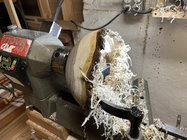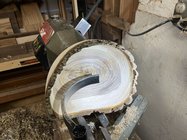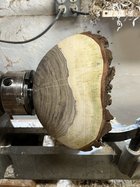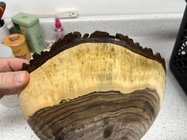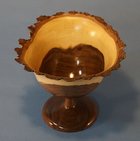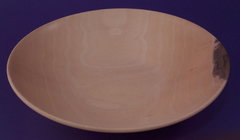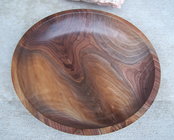Yesterday I was turning a live edge piece of walnut with the bark on, and what looked like mildew grew in the sapwood at an astonishing pace. As I hollowed the interior a few of the small brown spots in the white sapwood began to look more prominent. About 20 minutes into this I noticed green spreading across the end grain on the outside (and eventually the inside) of the sapwood. I completed the turning, this will be a once turned bowl, and put it in a paper bag while I did a little research. The tree was felled a month or so ago, cut into short lengths and Anchorseal applied to the ends. There was a little mildew visible when I prepped this log into two round blanks yesterday. The first one went onto the lathe within the hour.
I didn't find any consensus about what's going on, the two main opinions being 1) mildew can grow that quickly if it's already deep in the wood and is exposed to oxygen, or 2) it's not mildew at all, but "tannins" from the heartwood bleeding into the sapwood. Not being sure, I spritzed the bowl inside and out with diluted bleach to kill whatever might be growing. I hope it's superficial and will sand out. The bowl is back in a bag for a few days before I sand and remove the tenon.
Any ideas? Thoughts? Is this something common that I've missed so far? Thanks in advance, I'm really hoping to get rid of the dingy look if possible. Photos show the wood while turning and then later when sprayed with bleach. Thank you for any info.
I didn't find any consensus about what's going on, the two main opinions being 1) mildew can grow that quickly if it's already deep in the wood and is exposed to oxygen, or 2) it's not mildew at all, but "tannins" from the heartwood bleeding into the sapwood. Not being sure, I spritzed the bowl inside and out with diluted bleach to kill whatever might be growing. I hope it's superficial and will sand out. The bowl is back in a bag for a few days before I sand and remove the tenon.
Any ideas? Thoughts? Is this something common that I've missed so far? Thanks in advance, I'm really hoping to get rid of the dingy look if possible. Photos show the wood while turning and then later when sprayed with bleach. Thank you for any info.

